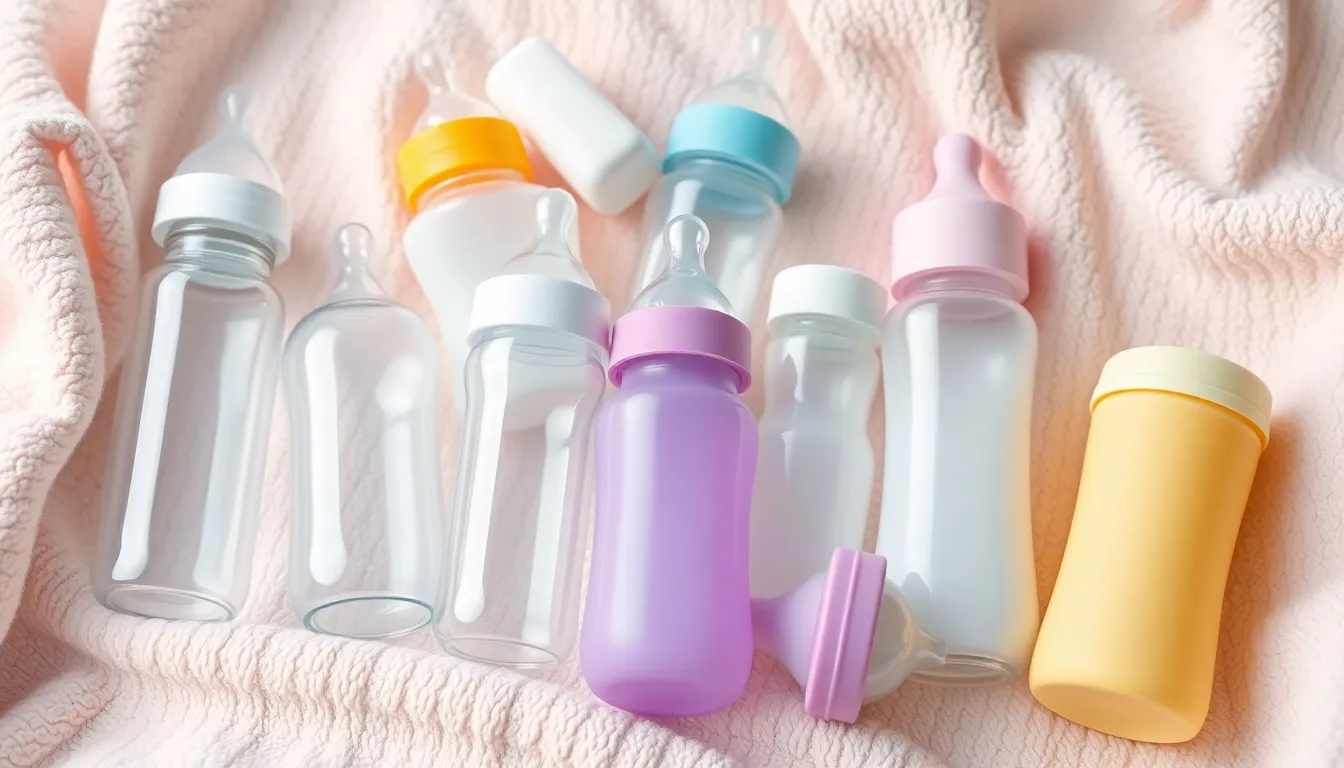Finding the right baby bottle for a newborn can feel like searching for a needle in a haystack. With countless options on the market, parents might wonder if they’re choosing the perfect match for their little one. After all, a happy baby means happy parents, and who doesn’t want a little peace and quiet amidst the chaos of diaper changes and sleepless nights?
Table of Contents
ToggleBest Baby Bottles for Newborns
Selecting the best baby bottles for newborns can significantly impact feeding. Consider these high-quality options known for their design and performance:
- Dr. Brown’s Original Bottle
Dr. Brown’s bottle features a unique vent system that reduces colic and gas. Its design closely mimics breast feeding, making it ideal for transitioning.
- Comotomo Baby Bottle
Comotomo bottles use soft silicone and a wide shape for easy grip. They come with a dual anti-colic vent system and are made to resemble a breast.
- Philips Avent Natural Bottle
Philips Avent Natural bottles contain a wide nipple that promotes a natural latch. These bottles are user-friendly and easy to clean.
- MAM Easy Start Anti-Colic Bottle
MAM bottles have a breast-like nipple shape, promoting easy transitions between breast and bottle. Their design includes a vented base to minimize air ingestion.
- Lansinoh mOmma Bottle
Lansinoh mOmma bottles feature a unique shape that encourages a natural latch. These bottles are lightweight and have a built-in anti-colic system.
- Nuk Simply Natural Bottle
Nuk Simply Natural bottles offer an ultra-wide nipple for a natural feeding experience. They are specially designed with multiple holes to mimic natural milk flow.
- Tommee Tippee Closer to Nature Bottle
Tommee Tippee bottles have a flexible nipple that moves with the baby’s mouth. Their anti-colic valve system ensures less air intake for a smoother feeding experience.
Parents should consider each bottle’s design, ease of cleaning, and features before making a choice. Opting for bottles that accommodate both breast and bottle feeding often creates a smoother transition for newborns. Review product specifics and check user feedback for the best fit.
Factors to Consider

Selecting the right baby bottle involves several important factors. Understanding these elements helps ensure a baby receives proper nutrition comfortably.
Material Types
Common materials for baby bottles include glass, plastic, and silicone. Glass bottles offer durability and do not absorb odors. Plastic options are lightweight and less likely to break. Silicone bottles are flexible, making them easier for babies to hold. Each material has pros and cons, so consider safety and ease of cleaning when choosing.
Bottle Shape and Size
Bottle shape and size impact feeding experience. Different shapes promote various sucking positions, which can help prevent colic. Smaller bottles suit newborns who consume less milk, while larger sizes accommodate growing appetites. Choose a shape that aligns with the baby’s comfort and feeding style.
Top Picks Reviewed
This section highlights top baby bottles for newborns, emphasizing features and usability that make each choice stand out.
Dr. Brown’s Original Bottle
Dr. Brown’s Original Bottle features a unique internal vent system designed to reduce colic and gas. This bottle promotes a steady flow of milk, allowing babies to drink without swallowing excess air. Constructed from high-quality plastic, it’s lightweight and easy to handle. Parents appreciate that all parts can be disassembled for thorough cleaning. The beauty of this bottle lies in its compatibility with breastfed babies, making the transition to bottles smoother.
Comotomo Baby Bottle
Comotomo Baby Bottles boast a soft, squeezable design that mimics a mother’s breast. The wide neck enables easy filling and cleaning, reducing stress for parents during busy feeding times. Made from medical-grade silicone, these bottles are both durable and free from harmful chemicals. Multiple nipples with varying flow rates offer flexibility as the baby grows. The anti-colic venting system ensures that babies experience less gas and discomfort.
Philips Avent Natural Bottle
Philips Avent Natural Bottle incorporates a breast-shaped nipple that encourages natural latch-on. Designed with soft, flexible material, this bottle suits babies transitioning from breastfeeding to bottle-feeding. The wide neck simplifies filling and cleaning, which makes this an appealing option for busy parents. It features an integrated anti-colic system that reduces air intake, promoting a calmer feeding experience. Multiple nipple flow rates cater to different stages of feeding.
Tips for Bottle Feeding Newborns
Selecting the right bottle for a newborn can impact their feeding experience. Choose bottles with a slow flow nipple. This type of nipple mimics breastfeeding and prevents overwhelming the baby. Observe the baby’s cues during feeding; they may need breaks or a change in position.
Maintain a calm environment while feeding. Reducing distractions helps the baby focus on breastfeeding or bottle feeding. Keep the bottle at an angle that allows the nipple to stay filled with milk, preventing the baby from swallowing air. This practice helps minimize gas and discomfort.
Disinfect bottles regularly, especially in the early weeks. Boiling bottles or using a dishwasher on the top rack promotes hygiene. Clean bottles thoroughly after each use to eliminate bacteria. Use bottle brushes for hard-to-reach areas, ensuring a safe feeding solution.
Experiment with different bottle types and nipples. Newborns may prefer a particular shape or material, so flexibility in choices can aid in finding the best fit. Observe how the baby reacts to each bottle to gauge comfort and acceptance.
Consult pediatricians for advice tailored to specific needs. They can address concerns such as feeding difficulties or allergies. Engage with other parents for shared experiences and recommendations, creating a network for support.
Stay patient and consistent while introducing bottles. Transitioning from breast to bottle can take time. Offer the bottle during calm moments, allowing the baby to adjust gradually. Adapting feeding practices promotes a positive experience for both the baby and the parents.
Choosing the right baby bottle for a newborn can significantly enhance the feeding experience. With various options available parents can find bottles that cater to their baby’s needs while ensuring comfort and ease of use. Prioritizing features such as anti-colic systems and breast-like designs can make a world of difference in transitioning between breastfeeding and bottle feeding.
By considering factors like material type shape and size parents can select bottles that not only promote healthy feeding habits but also contribute to a peaceful household. Engaging with other parents and seeking advice from pediatricians can provide valuable insights into making the best choice. Ultimately patience and consistency are key to fostering a positive feeding journey for both baby and parent.



